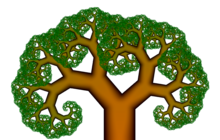This is a purely constructive Coq development for computing solutions to recursive domain equations as colimits (i.e., suprema) of ω-chains in the category Cpoep (objects are CPOs and morphisms are embedding-projection pairs).
It is similar to defining a recursive type as the fixed point of a functor F (the initial F-algebra), but the resulting type is a CPO with a constructive supremum operation.
A common construction (of, e.g., recursive functions) within a CPO (an ordered set formalizing a datatype) is to take the supremum of an ascending chain (ω-chain) of elements of the CPO. The intuition is that each element of the chain is a better approximation than its predecessor of the value we are trying to approximate. The chain tends toward a limit which can be obtained by taking its supremum.
We define a chain by giving some finite generating function which produces each new element of the chain as a function of its predecessor, starting from a bottom element ⊥. The limit of the sequence induced by ths generating function may be infinite, so in effect this is merely a way of describing potentially infinite values in finite terms (not so much different from the use of loops or recursion in programming languages).
This idea can be lifted up a level, so that instead of defining a chain within a particular CPO, we define a chain of CPOs within Cpo, the category of CPOs. We first generalize some notions in terms of category theory to ease the transition.
Now, an ω-chain in Cpo is technically a diagram (indexed by the preorder category of natural numbers) in Cpo, and the supremum of the chain is the colimiting cocone of the diagram. The generating function is now a functor (similar to initial algebra constructions), which induces an ω-chain produced by iterative application of the functor starting from ⊥ (the unit type, which is the initial object in Cpo). The colimit of such a diagram is itself an object in Cpo, and is exactly the one we are hoping to obtain.
Due to technical issues related to contravariance of the first argument of the function space functor, we move from Cpo, in which the morphisms are Scott continuous mappings, to the category Cpoep, in which the morphisms are embedding-projection pairs instead.
An embedding-projection pair between two CPOs A and B is a pair of continuous mappings:
- embed : A → B
- proj : B → A
such that:
- proj ∘ embed = idA
- embed ∘ proj ≤ idB
witnessing the fact that B is in some sense a better approximation than A (A ⊑ B), because A can be faithfully embedded (preserving order) within B.
Given any ω-chain C in Cpoep, we can construct its colimit as the type of infinite chains such that, for every chain, the ith element has type Ci, and is equal to the projection of its successor xi = proj xi+1. This is sometimes called the projective limit of the chain.
One necessary condition on the functors used in this construction is that they are continuous functors, in the sense that they preserve colimits. We use a slightly weird version of this continuity property, which suffices for our needs but lacks the full generality of the usual one.
A user of this library can define a functor F using the provided functor combinators, and apply the projective limit construction to obtain a type μF (along with an order relation and constructive supremum operation) which is the solution (unique up to isomorphism) to the following isomorphism (we may loosely call it an equation):
X ≃ F X
The user also receives two continuous mappings, fold and unfold:
- fold : X → F X
- unfold : F X → X
such that:
- unfold ∘ fold = idX
- fold ∘ unfold = idF X
- constant
- identity
- product (bifunctor)
- continuous function space (bifunctor)
TODO: there are still a few admits in ProjectiveLimit.v, mostly related to an operation that is theoretically trivial but annoyingly difficult to define in Coq.

